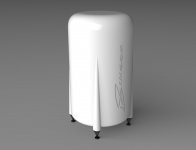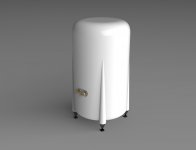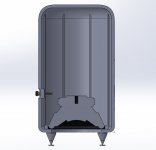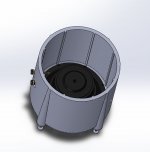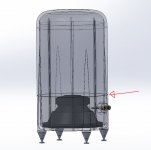Hi all, this will be my first subwoofer build. I've got some experience making 3D printed full-range speakers that hopefully will help me out, but I'm sure lots to learn. I'm building this to pair it with my full-range speakers I posted here.
I'll be using a Boss CXX8, an 8-inch 4-ohm driver. It's cheap and I'm sure nothing too special but I've had it lying around for a couple years. I'm considering this a learning experience before I lay out more cash for something that will undoubtedly be better the second time around. My enclosure will be overall cylindrical in shape, with an internal cavity of approximately 15.5" tall and a 9.25" diameter. The sizing should meet the driver's recommended volume, but because I'm 3D printing the housing I'm limited in dimensions by what my printers can fit. As it is, I'll have to break the housing up into two main components which will come together after printing (proposed cut line indicated in image with red arrow... haven't done the CAD work to show the closure mechanism yet)
I appreciate any feedback you have for a beginner!

I'll be using a Boss CXX8, an 8-inch 4-ohm driver. It's cheap and I'm sure nothing too special but I've had it lying around for a couple years. I'm considering this a learning experience before I lay out more cash for something that will undoubtedly be better the second time around. My enclosure will be overall cylindrical in shape, with an internal cavity of approximately 15.5" tall and a 9.25" diameter. The sizing should meet the driver's recommended volume, but because I'm 3D printing the housing I'm limited in dimensions by what my printers can fit. As it is, I'll have to break the housing up into two main components which will come together after printing (proposed cut line indicated in image with red arrow... haven't done the CAD work to show the closure mechanism yet)
I appreciate any feedback you have for a beginner!

Attachments
Why not just get an 8 or 10” D piece of PVC and print the top, feet, and baffle? I expect it would be stiffer, more solid, and cheaper.
dave
That's actually not a bad idea at all... I'll play around with what's possible that way. I did look quickly and saw that 10" PVC is still quite expensive, it would probably cost me similar to what the printing material would cost me. Also, I'd be printing it with a "wood" material that has ground wood fiber impregnated into the plastic which gives it sound properties similar to MDF. Printing the whole thing will give me finer control over the form (which isn't fully finished here yet) and I want this to be as visually pleasing as possible since it will be quite noticeable in the living room.
Still, I like the idea of using tubing as a component I will definitely explore that!

which gives it sound properties similar to MDF
A good reason to avoid it. MDF is not really a good speaker building material. It’s big asset is that it is cheap.
dave
A good reason to avoid it. MDF is not really a good speaker building material. It’s big asset is that it is cheap.
dave
For what it’s worth, it is stiffer and harder than mdf. Maybe that was a bad comparison, although I’m not sure exactly how to equate it... It sands very much like oak or hard wood, density wise it probably falls in between hard wood and mdf.
That's actually not a bad idea at all... I'll play around with what's possible that way. I did look quickly and saw that 10" PVC is still quite expensive, it would probably cost me similar to what the printing material would cost me. Also, I'd be printing it with a "wood" material that has ground wood fiber impregnated into the plastic which gives it sound properties similar to MDF. Printing the whole thing will give me finer control over the form (which isn't fully finished here yet) and I want this to be as visually pleasing as possible since it will be quite noticeable in the living room.
Still, I like the idea of using tubing as a component I will definitely explore that!

Wood filament is IMO 'silly' Being Neither wood nor plastic.. worst of both worlds.
IMO Find a road building/work site.
The workies will gladly hand over large diameter drain? water? or? pipe offcuts.
They can also be bribed with Beer.
Wood filament is IMO 'silly' Being Neither wood nor plastic.. worst of both worlds.
IMO Find a road building/work site.
The workies will gladly hand over large diameter drain? water? or? pipe offcuts.
They can also be bribed with Beer.
I’ve gotta disagree with you that’s its worse than plastic, based on my experience building 8 different prototypes of varying materials for my full range speaker project. Compared with normal PLA, ABS, PETG and then the wood/PLA hybrid material yielded a definite improvement in sound quality. The non-filled plastics all sounded echoey, tinny, like there was more internal reflection happening and more sound being radiated by the housing itself, even with the same drivers and wall thicknesses. It’s my understanding that it’s less rigid, but has some built in damping qualities. Probably not as good as real wood but my ears tells me it’s much better than basic plastic... at least basic 3D printed plastics. Whether it’s worse than a solid pvc tube is something I’m quite curious to experiment with. Until then it’s all heresay

Last edited:
Not all of us share Dave's disdain for MDF as the magnitude of its weakness is pretty small, but looking at your design, there's an opportunity to use a mixture of sonotube/PVC and 3d printed baffles. There's a chance to print ribs/spars in organic shapes that might work a lot better than the standard rectangular fare. Or infused dampening into said ribs/spars.
...The workies will gladly hand over large diameter drain? water? or? pipe offcuts.
They can also be bribed with Beer.
HA HA HA HA HA!!! Or meth, but beer is probably cheaper...
Not all of us share Dave's disdain for MDF as the magnitude of its weakness is pretty small, but looking at your design, there's an opportunity to use a mixture of sonotube/PVC and 3d printed baffles. There's a chance to print ribs/spars in organic shapes that might work a lot better than the standard rectangular fare. Or infused dampening into said ribs/spars.
Until this particular post, the idea of using a 3d printer in speaker building never even occurred to me. Now I'm picturing various small snail shell type horns or such for desktop satelites, perfectly flared port tubes or port tube ends... suddenly, I feel the need for a 3d printer...
The workies will gladly hand over large diameter drain? water? or? pipe offcuts.
They can also be bribed with Beer.
That is more or less how i got my big pieces. Didn’t need beer thou.
I have 2 tall 8” D pieces for an ML-TL, and shorter pieces for a pair of sealed push-push/push-pull 12” (4 for tube).
It paint up nice — i know a guy who could make a piece of PVC look like a marble column.
These used 6” pipes:
the toobs Mk 1
dave
The real advantage with using a 3d printer is making structures that would be very difficult or virtually impossible to fabricate using other methods.
Think tapered / shaped walls and integral internal bracing at least.
You literally need to think out of the box!
Think tapered / shaped walls and integral internal bracing at least.
You literally need to think out of the box!
- Status
- This old topic is closed. If you want to reopen this topic, contact a moderator using the "Report Post" button.
- Home
- Loudspeakers
- Subwoofers
- 8" downfiring sub in 3D printed housing
